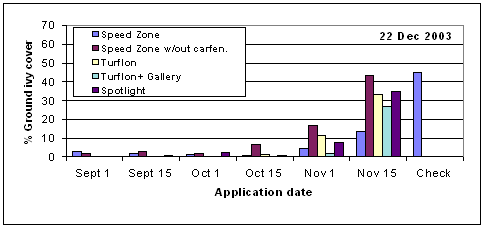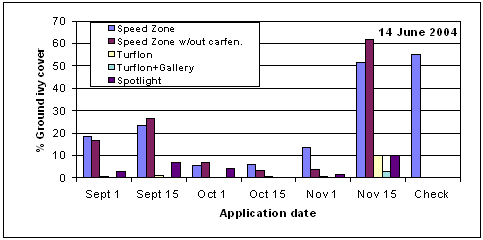Though many broadleaf weeds like ground ivy, clover, and plantain are currently thriving in turf areas, resist the urge to spray them now. Following is a summary of a study that we discussed at Field Day that can help professionals improve broadleaf weed control, especially difficult-to-control weeds like ground ivy.
Background
Ground ivy is difficult to control and it is a problem in 31% of lawns maintained professionally in Indiana . Earlier research by Eric Kohler has expanded our understanding of ground ivy including:
- Annual nitrogen rates above 2 lbs N/1000 sq ft decreases ground ivy.
- The broadleaf preemergence herbicide isoxaben reduces ground ivy.
- The full-labeled rate of broadleaf herbicides maximizes ground ivy control.
- Triclopyr, 2,4-D, and fluroxypyr are some of the better herbicides for controlling ground ivy.
- Dicamba, clopyralid, and quinclorac have little effect on ground ivy.
- Efficacy of slower-acting herbicides such as triclopyr applied in the fall may not become apparent until the following spring.
- Populations of ground ivy exist that have differential susceptibility to herbicides. For instance, one population may not be sensitive to 2,4-D while a neighboring population is extremely sensitive to 2,4-D. Therefore, it is important to alternate herbicides when attempting ground ivy control.
We suspect that application date has an effect on fall ground ivy control. Plus it is important to evaluate the newer herbicides for ground ivy control. The newer herbicides we evaluated in this study are PBI Gordon’s Speedzone (active ingredients are carfentrazone, 2,4-D, dicamba, and MCPP) and Dow’s Spotlight (active ingredient is fluroxpyr).
Objective
To evaluate five different combinations of herbicides applied from Sep 1 through Nov 15 on control of ground ivy.
How It Was Done
Field plots (5 by 5 ft) were located in full sun in a low-maintenance stand of Kentucky bluegrass that have received marginal fertilization previously. Plots were irrigated as needed to prevent drought stress and mowed three times per week at 2.5 inches with clippings returned. All herbicide treatments were applied in 2 gal/1000 sq ft water with a CO 2 -pressurized backpack sprayer using a three-nozzle (TeeJet XR8002VS) boom at 35 psi. Treatments were arranged in a 5 X 6 factorial (plus the untreated check) as follows:
5 Herbicides and rates
Speed Zone 5 pt/A
Speed Zone w/out carfentrazone. 5 pts/A
T urflon 2 pts/A
Turflon 2 pts/A + Gallery 1.33 lb/A
Spotlight 1.33 pts/A
6 Application dates
Sep 1
Sep 15
Oct 1
Oct 15
Nov 1
Nov 15
Ground ivy cover was monitored throughout the fall and following spring. This study will be repeated starting in Fall 2004 and Fall 2005. Since this was the initial year of study, this experiment was not fully analyzed statistically and the results are therefore still preliminary.
Results to Date
- When rated in Dec 2003, all treatments applied 1 Sep through 15 Oct provided adequate control of ground ivy, reducing cover to 5% or less compared to 45% cover in the check plots (Fig. 1).
- Applications made on 1 Nov and 15 Nov did not provide adequate control by 22 Dec, probably because of cool weather reducing visible control (Fig. 1).
- Carfentrazone in Speedzone increased short-term control as measured 22 Dec, especially in applications made 15 Oct through 15 Nov (Fig. 1).
- The best long-term control (measured June 2004) was from applications made from 1 Oct to 1 Nov, regardless of herbicide combination (Fig 2).
- Turflon, Turflon+Gallery, and Spotlight provided the best long-term control regardless of application date (Fig 2).
- Adding Gallery to Turflon improved long-term control of ground ivy (Fig 2).
- Carfentrazone in Speedzone did not inhibit long-term control. (Fig. 2)
- Long-term control from Speedzone (with or without carfentrazone) was the poorest among all treatments, regardless of application date. The active ingredient in Speedzone that would be most responsible for ground ivy control is 2,4-D, but we have shown before that some populations are not susceptible to 2,4-D. Our ground ivy population may not be highly susceptible to 2,4-D.
- Assuming that our population is not highly susceptible to 2,4-D, adequate long-term control was still obtained from Speedzone (with and without carfentrazone) when applied 1 Oct, 15 Oct, and 1 Nov.

Figure 1. Effect of five herbicides applied from Sept 1 through Nov 15 on short-term ground ivy control as measured in December.

Figure 2. Effect of five herbicides applied from Sept 1 through Nov 15 on long-term ground ivy control as measured in the following June.